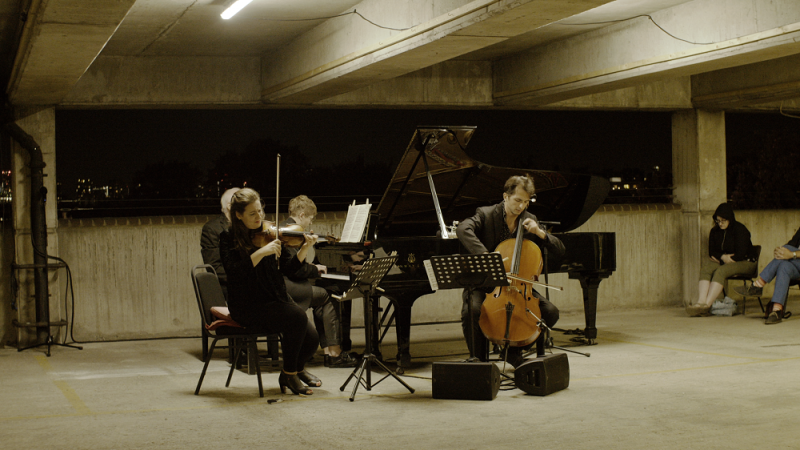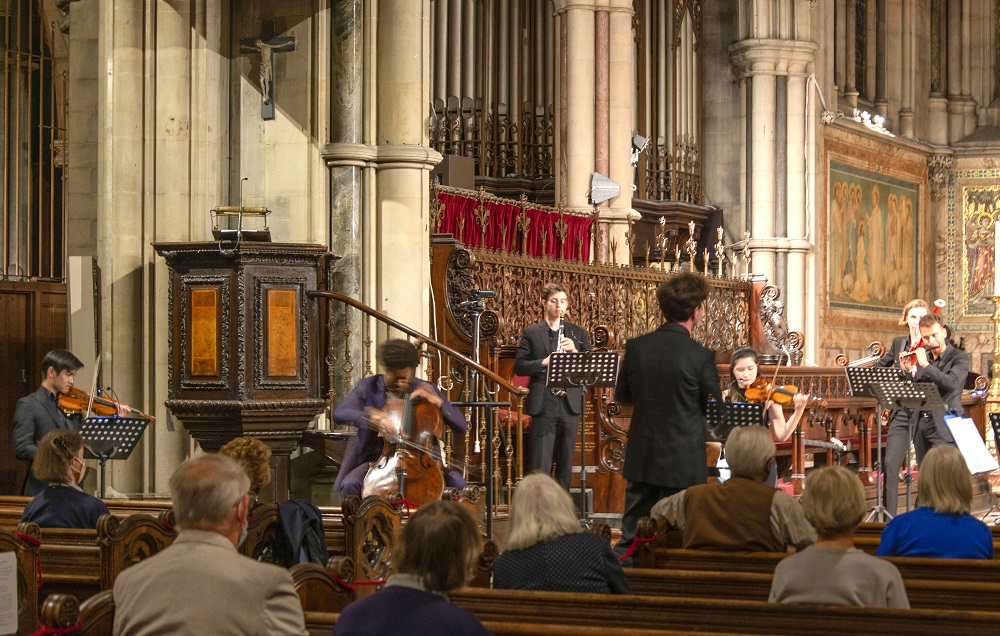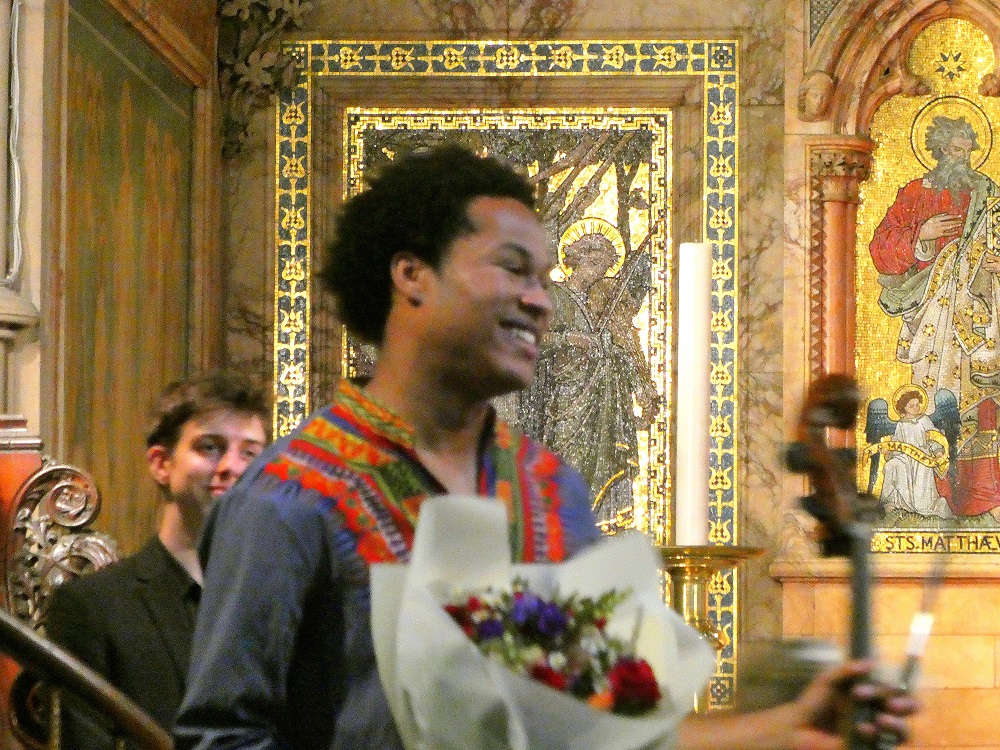A London Saturday with Sheku Kanneh-Mason, Pavel Kolesnikov, Samson Tsoy and friends - review | reviews, news & interviews
A London Saturday with Sheku Kanneh-Mason, Pavel Kolesnikov, Samson Tsoy and friends - review
A London Saturday with Sheku Kanneh-Mason, Pavel Kolesnikov, Samson Tsoy and friends - review
From a Dvořák concerto debut in a Kensington church to trios in a Peckham car park

Even bigger things have happened to Sheku Kanneh-Mason since I last saw him performing alongside his contemporaries in the Fantasia Orchestra – That Royal Wedding, for instance, and a Decca contract. Yet it looks like he will always have the wisdom to hurry slowly.
That in itself was a brilliant idea on the part of enterprising young conductor Tom Fetherstonhaugh. Ecclesiastical acoustics – previous performances had just taken place in Wells Cathedral – tend to muddy full orchestral forces, but with a string quintet led by consummate first violinist Anthony Poon (pictured below left with Kanneh-Mason, clarinettist James Gilbert, Fetherstonhaugh, second violinist Hana Mizuta-Spencer, bassoonist Patrick Bolton and flautist Jaymee Coonjobeeharry) projecting endlessly beautiful phrases from the opening of Wagner’s Siegfried Idyll onwards, the lines were clear throughout, and detail from the same number of wind players drew an even closer similarity of mittelEuropean identity between Wagner and Dvořák. All we missed, perhaps, were the trumpet calls at the ends of the concerto’s outer movements.  Much easier, though, for Kanneh-Mason, as engaging to watch listening to other players as when he plays himself, to tune in to the sonorities around him. One of the most heart-leaping moments of the concerto performance was that extension of Dvořák’s slow-movement melody on two clarinets – here bassoonist Patrick Bolton blended perfectly in thirds and sixths with James Gilbert – with the cello rising to meet them: pure introspective magic from the soloist, and there were so many passages of hushed magic, as compelling as any interpretation of the work I’ve heard.
Much easier, though, for Kanneh-Mason, as engaging to watch listening to other players as when he plays himself, to tune in to the sonorities around him. One of the most heart-leaping moments of the concerto performance was that extension of Dvořák’s slow-movement melody on two clarinets – here bassoonist Patrick Bolton blended perfectly in thirds and sixths with James Gilbert – with the cello rising to meet them: pure introspective magic from the soloist, and there were so many passages of hushed magic, as compelling as any interpretation of the work I’ve heard.
It was the most directly emotional music to be experienced live post-lockdown, and the candid loveliness of the Siegfried Idyll served as more than a mere prelude. Wagner’s chamber original had to be adapted slightly (by David Walter) to do without three players, but there were hardly any gaps in the textures and though we lost a second horn, the first – Alexei Watkins – waxed heroic in the famous forest call. All the wind got a chance to shine in the encore, an arrangement of Balkan folksong "Ajde Jano" by Kanneh-Mason and Fetherstonehaugh, flautist Jaymee Coonjobeeharry supreme among the improvisers.
With the possible exception of Arvo Pärt’s lightly-coated Mozart-Adagio – the slow movement of Mozart’s F major Piano Sonata, K280, with distinctly Pärtian comments – there was no late-night easy listening about this programme: Beethoven’s early Trio in C minor, Op. 1 No. 3, and the dauntingly big-boned “Archduke” (B flat) Trio composed require total concentration from the listener. Kolesnikov makes playful idiosyncrasy out of even the more conventional stretches of Beethoven’s piano writing, but as in Igor Levit’s Wednesday recital, scherzo trios really drove home the sheer originality of the composer: the bravura flourishes of youth in the C minor Trio,, the creepy chromatics in the second movement of the “Archduke”, which might just as well be nicknamed “Ghost” at that point.  By then, not far off 11pm, this particular spirit was willing but the flesh was weak for a typically extended set of variations – the fourth of the evening – and so I’m probably not the best person to ask about the later wonders. And it’s my blind spot, but I don’t find these extraordinary works as easy to love as I do trios by Schubert, Mendelssohn, Brahms and Tchaikovsky: but when I next hear those works, there are no players I’d rather hear in them than these three, consummate musicians all.
By then, not far off 11pm, this particular spirit was willing but the flesh was weak for a typically extended set of variations – the fourth of the evening – and so I’m probably not the best person to ask about the later wonders. And it’s my blind spot, but I don’t find these extraordinary works as easy to love as I do trios by Schubert, Mendelssohn, Brahms and Tchaikovsky: but when I next hear those works, there are no players I’d rather hear in them than these three, consummate musicians all.
The real tour de force of the evening came earlier, in Samson Tsoy’s recital. As in the castle at Lerici on Italy’s Ligurian coast, where I first heard him, Tsoy (pictured below) unfolded Schubert’s first set of Impromptus (D899) as an interrelated four-movement sonata (the fact that the G flat major Andante is the balm to the preceding whirl, which starts in the major and ends in the minor, gets lost in detachment; the pianist was quick on each uptake). It was right, too, to have another Impromptu as encore after the giddying climactic majesty of Brahms’s Variations and Fugue on a Theme of Handel.  Only an encyclopedic interpretative imagination can match Brahms’s range, from witty spring to Titanic sport and every shade around them, and Tsoy’s – enlightened, no doubt, by recent study of the work in Vienna with his and Kolesnikov’s great friend and mentor, Elisabeth Leonskaja – rose to the challenge, resonating within the amazingly good acoustics of the car-park level below the roof. A sunset beyond the towers of the City skyline complemented it all. If there are tickets left, and no drastic government restrictions turn it all to dust, don’t miss Kolesnikov and Tsoy in amazing company at their second Ragged School Festival in the East End at the start of October. Theirs is already the gold medal of lockdown heroism, as a perfect cue to other musicians in adapting to the difficult spirit of the time.
Only an encyclopedic interpretative imagination can match Brahms’s range, from witty spring to Titanic sport and every shade around them, and Tsoy’s – enlightened, no doubt, by recent study of the work in Vienna with his and Kolesnikov’s great friend and mentor, Elisabeth Leonskaja – rose to the challenge, resonating within the amazingly good acoustics of the car-park level below the roof. A sunset beyond the towers of the City skyline complemented it all. If there are tickets left, and no drastic government restrictions turn it all to dust, don’t miss Kolesnikov and Tsoy in amazing company at their second Ragged School Festival in the East End at the start of October. Theirs is already the gold medal of lockdown heroism, as a perfect cue to other musicians in adapting to the difficult spirit of the time.
- Details of the Ragged Music Festival 2
- Samson Tsoy and Pavel Kolesnikov guest on David Nice's Russian Music Zoom course. A second term is planned
- More classical music reviews on theartsdesk
rating
Explore topics
Share this article
The future of Arts Journalism
You can stop theartsdesk.com closing!
We urgently need financing to survive. Our fundraising drive has thus far raised £49,000 but we need to reach £100,000 or we will be forced to close. Please contribute here: https://gofund.me/c3f6033d
And if you can forward this information to anyone who might assist, we’d be grateful.

Subscribe to theartsdesk.com
Thank you for continuing to read our work on theartsdesk.com. For unlimited access to every article in its entirety, including our archive of more than 15,000 pieces, we're asking for £5 per month or £40 per year. We feel it's a very good deal, and hope you do too.
To take a subscription now simply click here.
And if you're looking for that extra gift for a friend or family member, why not treat them to a theartsdesk.com gift subscription?
more Classical music
 BBC Proms: Barruk, Norwegian Chamber Orchestra, Kuusisto review - vague incantations, precise laments
First-half mix of Sámi songs and string things falters, but Shostakovich scours the soul
BBC Proms: Barruk, Norwegian Chamber Orchestra, Kuusisto review - vague incantations, precise laments
First-half mix of Sámi songs and string things falters, but Shostakovich scours the soul
 BBC Proms: Alexander’s Feast, Irish Baroque Orchestra, Whelan review - rapturous Handel fills the space
Pure joy, with a touch of introspection, from a great ensemble and three superb soloists
BBC Proms: Alexander’s Feast, Irish Baroque Orchestra, Whelan review - rapturous Handel fills the space
Pure joy, with a touch of introspection, from a great ensemble and three superb soloists
 BBC Proms: Moore, LSO, Bancroft review - the freshness of morning wind and brass
English concert band music...and an outlier
BBC Proms: Moore, LSO, Bancroft review - the freshness of morning wind and brass
English concert band music...and an outlier
 Willis-Sørensen, Ukrainian Freedom Orchestra, Wilson, Cadogan Hall review - romantic resilience
Passion, and polish, from Kyiv's musical warriors
Willis-Sørensen, Ukrainian Freedom Orchestra, Wilson, Cadogan Hall review - romantic resilience
Passion, and polish, from Kyiv's musical warriors
 BBC Proms: Faust, Gewandhausorchester Leipzig, Nelsons review - grace, then grandeur
A great fiddler lightens a dense orchestral palette
BBC Proms: Faust, Gewandhausorchester Leipzig, Nelsons review - grace, then grandeur
A great fiddler lightens a dense orchestral palette
 BBC Proms: Jansen, Royal Concertgebouw Orchestra, Mäkelä review - confirming a phenomenon
Second Prom of a great orchestra and chief conductor in waiting never puts a foot wrong
BBC Proms: Jansen, Royal Concertgebouw Orchestra, Mäkelä review - confirming a phenomenon
Second Prom of a great orchestra and chief conductor in waiting never puts a foot wrong
 BBC Proms: Royal Concertgebouw Orchestra, Mäkelä review - defiantly introverted Mahler 5 gives food for thought
Chief Conductor in Waiting has supple, nuanced chemistry with a great orchestra
BBC Proms: Royal Concertgebouw Orchestra, Mäkelä review - defiantly introverted Mahler 5 gives food for thought
Chief Conductor in Waiting has supple, nuanced chemistry with a great orchestra
 Dunedin Consort, Butt / D’Angelo, Muñoz, Edinburgh International Festival 2025 review - tedious Handel, directionless song recital
Ho-hum 'comic' cantata, and a song recital needing more than a beautiful voice
Dunedin Consort, Butt / D’Angelo, Muñoz, Edinburgh International Festival 2025 review - tedious Handel, directionless song recital
Ho-hum 'comic' cantata, and a song recital needing more than a beautiful voice
 Classical CDs: Dungeons, microtones and psychic distress
This year's big anniversary celebrated with a pair of boxes, plus clarinets, pianos and sacred music
Classical CDs: Dungeons, microtones and psychic distress
This year's big anniversary celebrated with a pair of boxes, plus clarinets, pianos and sacred music
 BBC Proms: Liu, Philharmonia, Rouvali review - fine-tuned Tchaikovsky epic
Sounds perfectly finessed in a colourful cornucopia
BBC Proms: Liu, Philharmonia, Rouvali review - fine-tuned Tchaikovsky epic
Sounds perfectly finessed in a colourful cornucopia
 BBC Proms: Suor Angelica, LSO, Pappano review - earthly passion, heavenly grief
A Sister to remember blesses Puccini's convent tragedy
BBC Proms: Suor Angelica, LSO, Pappano review - earthly passion, heavenly grief
A Sister to remember blesses Puccini's convent tragedy
 BBC Proms: A Mass of Life, BBCSO, Elder review - a subtle guide to Delius's Nietzschean masterpiece
Mark Elder held back from blasting the audience with a wall of sound
BBC Proms: A Mass of Life, BBCSO, Elder review - a subtle guide to Delius's Nietzschean masterpiece
Mark Elder held back from blasting the audience with a wall of sound

Add comment